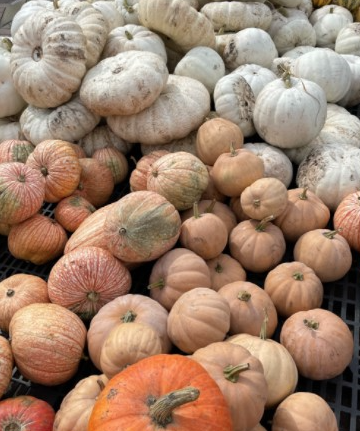Pumpkins, squash and gourds are from the Curcurbita genus. Very basically, the ones at Gertens are broken down into three main species; c. moschata, c. maxima and c. pepo. Oh, it gets more confusing from there but that's just TMI for the 'Scoop.
The experts at Gertens put gogether this handy guide to the Curcurbits that Gertens gets in. Note that they can and do change from year to year depending on availability.
The most frequently asked question is "can we eat them?". Yes, but not the gourds. They don't taste good and they're very hard to cook. However, the grourds are used in various crafts and have been used as tools. There's another use I won't mention here, you can look that up on your own!


Gourds
All the photos below show edibles:


White & Gold Acorn, Carnival, Turban, Delicata, Burgess


American Tondo, Carnival, Blue pumpkin


Blue Hubbard, Red Cinderella, Pink Banana


Flat White Boer, Autumn Bucks, One Too Many
What's Cooking America has an extensive list of all the pumpkins/squash you can cook and great explanations of the different types, how to prepare and cook them. They use different names for a few of them, but the photos help you through it. There are links to lots of recipes and, of course, you can always Google more!
Tip: Winter squash can be used as part of your decor outdoors for at least a month or more. Here's the thing, if critters or cold temps get at it before you bring it in, the squash won't be edible.
Note: There is a difference in how you choose winter squash (aka Autumn) and Summer squash that was harvested earlier, example would be zucchini and patty pan. Check out this article from my favorite magazine, Northern Gardener, on summer squash and cooking it. When choosing winter squash for cooking look for firm, well-shaped squash that are heavy for their size and have a hard, tough skin. Stay away from any that have sunken spots, mold, cuts or punctures. Remember to thoroughly wash the curcurbita before you cut it open.


Patty pan
Should you wish to grow them yourself, you'll need space and sunshine. Northern Gardener Magazine wrote a Plant Profile on them several years ago with a link to growing them.


Ahh, Autumn
Such a lovely time of year. Harvesting, decorating, viewing Fall colors and enjoying cool evening and bonfires. Don't forget the flannel shirts!
Looking forward to pumpkin pie and squash soup,
The Garden Scoop
